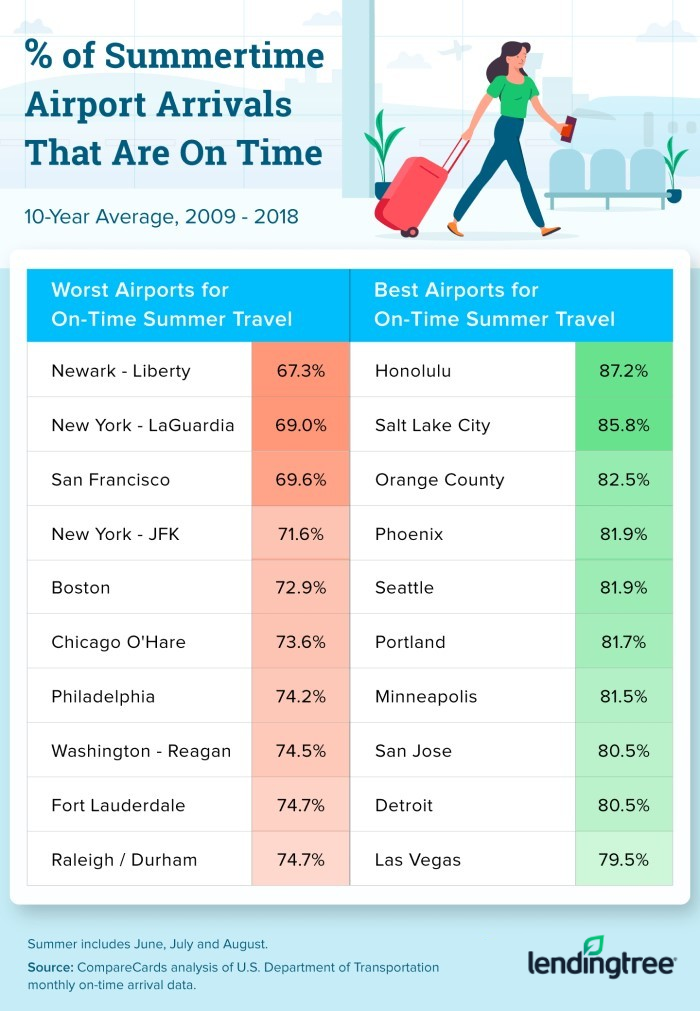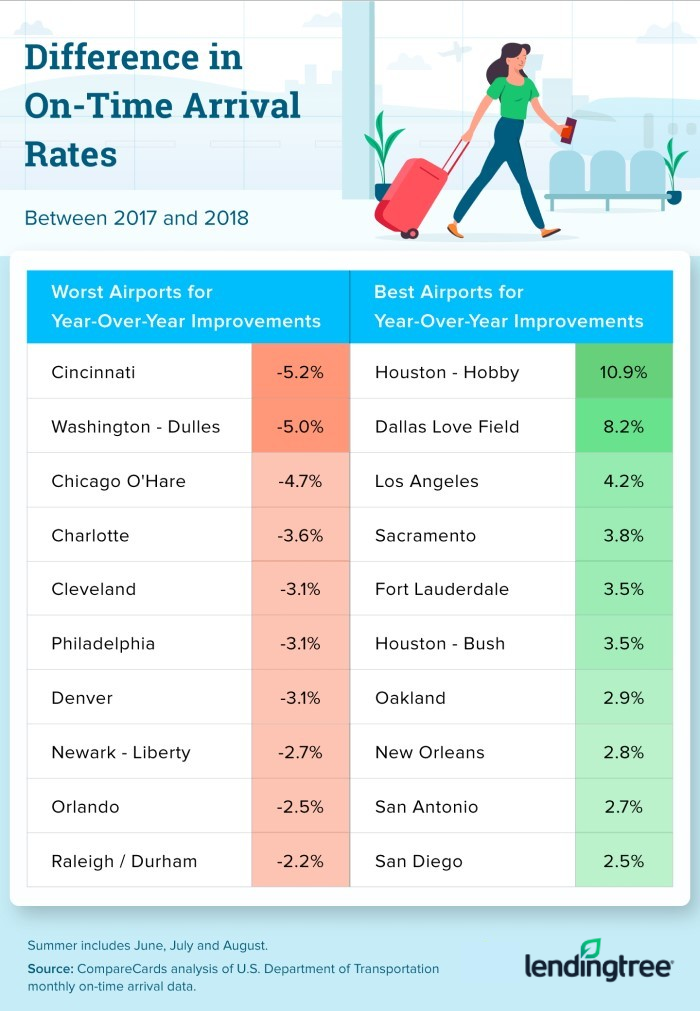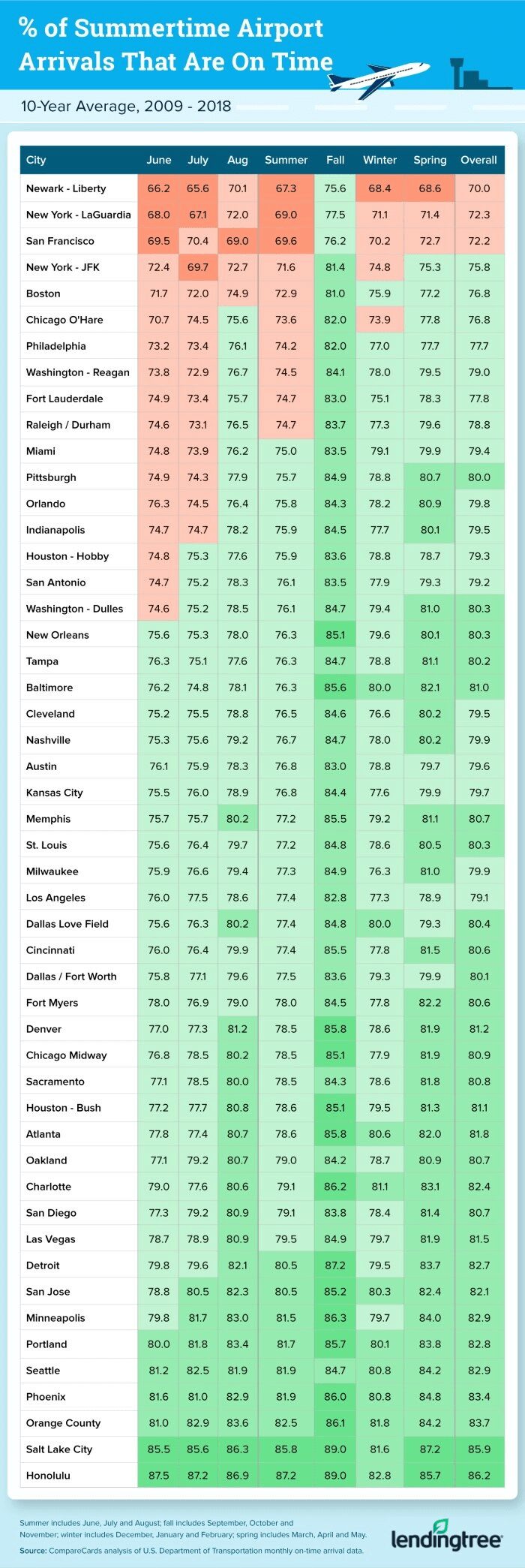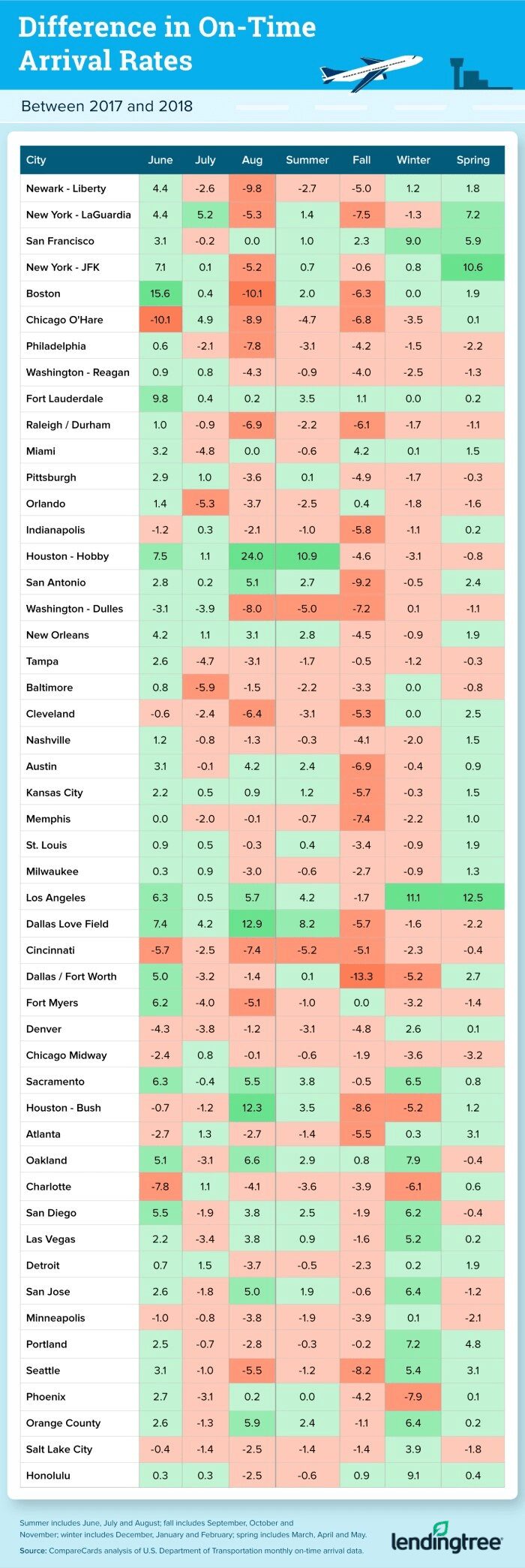Summer Flight Delay Study: Best And Worst Airports Ranked
As if there weren’t already a million good reasons why Hawaii is an amazing summer vacation destination, here’s another one: It’s really unlikely your flight will be delayed. According to a new report from LendingTree, Honolulu has had the greatest percentage of summertime flights arrive on time in the past 10 years, among the major airports in the United States.
The report, our fourth annual look at summer travel delays, tells a very different story for another of America’s favorite travel destinations, however. The big three airports in the New York – New Jersey metro area – John F. Kennedy (JFK), LaGuardia and Newark-Liberty – all ranked in the bottom four (along with San Francisco) among the nation’s 50 busiest airports when it comes to summer on-time arrivals, so you’ll need to pack your patience alongside your Yankees cap the next time you head to the Big Apple.
Whatever your destination, travel delays are no fun. Knowing that millions of credit cardholders around the nation will travel this summer, LendingTree analyzed 10 years of data for the nation’s 50 busiest airports from the U.S. Department of Transportation to see which airports tend to suffer the most frequent delays in the summertime. What we found, unfortunately but perhaps not surprisingly, is that delays ramp up during the summer season and in most places, the problem isn’t getting better. However, there are definitely airports where you’re less likely to encounter delays.
Key takeaways
- Big Apple, big delays: Newark-Liberty remains America’s most delay-ridden airport in the summer months. One out of three planes landed late between 2009 and 2018. Summer visitors to New York won’t get much relief by booking flights to other airports. The summer on-time arrival rate at LaGuardia (69%, second worst in the nation) and JFK (about 72%, fourth worst) weren’t much better. (San Francisco came in third at about 70%.)
- Airports in western cities dominate the top of the list: 87.2% of vacationers to Honolulu can expect to land on-time, making Hawaii that much more of an ideal destination. Salt Lake City and Orange County, Calif., came in second and third, with 10-year average on-time arrivals of about 86% and 83%, respectively. Phoenix, Seattle and Portland, Oregon were next on the list.
- Historically, June is the worst month for travel: It’s a hugely popular time for travel, but that also brings problems. The biggest arrival delays of the year happen in June for 30 out of 50 largest airports in the U.S.
- The rest of the summer isn’t great, either: It’s not just June. More than two-thirds of the 50 airports we reviewed have the worst 10-year average on-time arrival percentage of the year between June and August.
- Most airports are getting (a little) worse: More than half (27 of 50) of the airports we reviewed saw more delays from 2017 to 2018. Much of the movement we saw was small, however, with 17 of the 50 airports’ rates moving up or down by 1 percentage point or less.
- Where delays are getting worse: Cincinnati, Washington Dulles, and Chicago O’Hare saw the biggest increases in summer arrival delays between 2017 and 2018.
- Where delays shrunk the most: The biggest improvements between 2017 and 2018 came from Houston-Hobby, Dallas Love Field, and Los Angeles International (LAX). Sacramento and Fort Lauderdale also saw big improvements.

Click here to see the complete list.
The worst airports for summer delays
Most of the airports with the worst track records for on-time arrivals have a few things in common.
- They’re in the northeastern part of the country: All but two of the eight worst airports are found between Washington, D.C., and Boston. That makes for some incredibly crowded airspace in that neck of the woods, and all it really takes is one poorly-timed summer thunderstorm to throw flights off schedule.
- They’re among the nation’s busiest: The five airports with the worst on-time records all rank among the nation’s 20 busiest airports. Interestingly, however, Atlanta’s Hartsfield-Jackson Airport – for many years the busiest airport in the world – had a strong on-time record. Its summertime on-time arrival rate was the 14th best among the nation’s 50 busiest airports.
- They’re hubs for major airlines: Hubs vary by airline, but the worst offenders in our on-time surveys all serve as hubs for at least one major airline: Newark-Liberty (United), LaGuardia (American, Delta), San Francisco (United), JFK (American, Delta, JetBlue), and Boston (Delta, JetBlue). Being a hub means more traffic going to and from more different places – and a lot more things that can go wrong and cause delays.
- They’re along the coasts: Nine of the 10 cities with the worst on-time arrival track record in the summertime are either on the east or west coast. (Only Chicago O’Hare, the sixth worst, isn’t in a state that borders an ocean.) Compare that to the 10 cities with the best on-time arrival rates, which include five cities that aren’t on the coast.

Click here to see the complete list
The most improved airports
Hurricane Harvey brought staggering amounts of devastation to the Texas coast in 2017. Operations at both major Houston airports (Hobby and Bush) were heavily affected, too, as thousands of flights were canceled in the wake of the storm. That disruption led to Houston Hobby having the biggest drop in on-time arrivals in 2018’s Summer Flight Delay Study. (Our yearly reports examine on-time arrival data from the previous year, so the 2018 report would examine data from 2017, for example.)
That’s why it shouldn’t be surprising to see that Hobby had the biggest improvement in on-time arrivals in the 2019 survey, a 10.9% year-to-year increase. Dallas Love Field and Houston-Bush, both of which would have had flight schedules impacted by the hurricane, were also among the six biggest improvements.
The bottom line: Delays happen. Be flexible.
If you’ve flown at all, you probably have flight-delay nightmare stories to share. We all do. Flight delays are often part of the price you pay for taking that dream trip with the family or that romantic honeymoon with your beloved. The good news, however, is that there are steps that you can take to reduce the chances of running into delays – or at least make the best of them when they happen.
Fly nonstop: The more connections you have to make, the higher the probability for delays. It may cost you a little extra to take that nonstop flight, but the travel time you’ll save – and the potential headaches you may avoid – can be well worth the cost.
Take the first flight of the day: Oftentimes, flight delays happen because the plane that will take you to your next destination is late arriving from its previous location. However, taking the first flight of the day likely means that your plane spent the night at the airport and will be waiting for you when you arrive. Yes, waking up early can be brutal, especially if you have a big family to wrangle, but it can be worth it if it means ensuring a smooth, on-time flight.
Consider alternative airports: If the only way to get your destination from your hometown airport involves two plane changes and six hours of layovers at airports with crummy on-time arrival track records, don’t be afraid to look at alternatives. For example, San Francisco’s airport had the third-worst summer on-time arrival rate, but San Jose’s airport had the nation’s eighth best and Oakland’s had the 13th best. Upon further examination, sometimes other factors – which airlines fly out of that airport, whether nonstops are available and so on – will make those other airports not a realistic alternative, but it can be worth exploring.
Plan way in advance: The nearer your travel time, the more your options shrink. If you want to be able to have maximum flexibility when it comes to stops, travel times, pricing and locations, the sooner you begin looking and booking, the better.
Take advantage of credit card perks: That unexpected flight delay feels a whole lot less frustrating if you can spend it in an airport lounge with some complimentary refreshments. High-end travel cards like The Platinum Card® from American Express (enrollment required) and Chase Sapphire Reserve® come with free access to more than a thousand airport lounges around the world. (For a lower-annual-fee option, consider the Hilton Honors American Express Surpass® Card.) Just know that there’s often a limit to the number of guests you can bring in with you, so it might not be a solution if you’re traveling in a big group.
That lounge access only goes so far. However, if worse comes to worse and your flight delay leaves you stuck overnight, some credit cards will reimburse you up to a certain dollar amount for lodging and meals. Those cards include Chase Sapphire Reserve® and the lower-priced Chase Sapphire Preferred® Card, as well as the The New United℠ Explorer Card and the Bank of America® Premium Rewards® credit card. That can be a lifesaver, financially.
Lean on apps: Make sure you download your airlines’ app on your smartphone. Often, the first word you’ll get about a flight delay will come from there. Also consider Flightview, which allows you to track travel delays around the nation in real time.
Ultimately, successful travel often comes down to being prepared. If you begin looking for flights months in advance, it can save you money and give you many options. If you think to pack books, games or electronic devices for the kids, it can help you survive a long layover with the family without your head exploding. If you take the time to look at what your credit card has to offer before your trip, it can save you some potential headaches and maybe even some money if a nightmare scenario unfolds.
Of course, this is often easier said than done. We’re all incredibly busy, with to-do lists that are a mile long. However, if you prioritize planning for your trip, you can likely find the time to do these things, and once you do, the prospect of a flight delay or two might just seem a little less scary.
Complete survey results
Methodology
Using airport arrival data for the 50 busiest US airports from the U.S. Department of Transportation, we determined which airports tend to suffer the most delays during the summer travel season — which includes the months of June, July and August. Ten years of monthly data (2009 – 2018) was averaged across seasons and summer months.
Fall contains the following months: September, October and November. Winter contains the following months: December, January, and February. Spring contain the following months: March, April and May.
To see rates & fees for American Express cards mentioned on this page, visit the links provided below:
The content above is not provided by any issuer. Any opinions expressed are those of LendingTree alone and have not been reviewed, approved, or otherwise endorsed by any issuer. The offers and/or promotions mentioned above may have changed, expired, or are no longer available. Check the issuer's website for more details.




